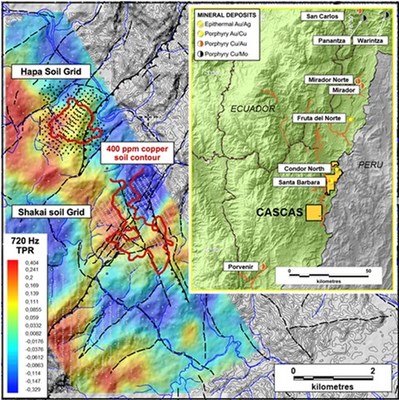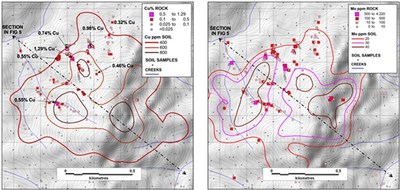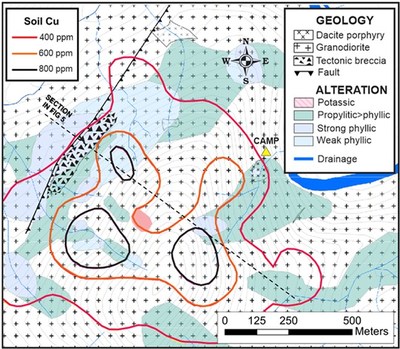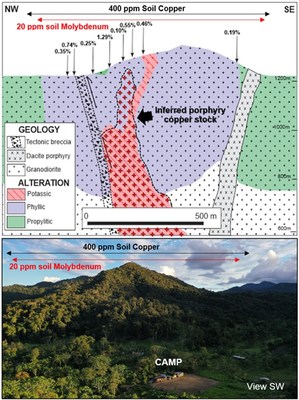Luminex Discovers a New Porphyry Copper Target at Cascas
Rhea-AI Summary
Luminex Resources Corp. has announced the discovery of a new porphyry copper target named Hapa, located in its 100% owned Cascas property in Ecuador. This target features a 1 km diameter copper/molybdenum anomaly, with rock chip samples showing up to 1.29% copper and 0.33% molybdenum. Geological mapping indicates a significant copper porphyry intrusion below the anomaly, suggesting potential for secondary copper enrichment. The discovery is a key addition to Luminex's extensive mineral resource portfolio within a region known for porphyry copper systems.
Positive
- Discovery of Hapa porphyry copper target enhances resource potential.
- Rock chip samples indicate high grades: up to 1.29% copper and 0.33% molybdenum.
- Potential for secondary copper enrichment suggested by geological data.
Negative
- None.
News Market Reaction 1 Alert
On the day this news was published, LUMIF gained 1.67%, reflecting a mild positive market reaction.
Data tracked by StockTitan Argus on the day of publication.
Highlights:
- The Hapa "Bullseye" target is a 1 km diameter coincident soil copper/molybdenum anomaly
- Part of a trend of porphyry copper systems discovered in western Cascas
- Rock chip and channel samples assaying as high as
1.29% copper and0.33% molybdenum
VANCOUVER, BC, Sept. 24, 2021 /PRNewswire/ - Luminex Resources Corp. (TSXV: LR) (OTCQX: LUMIF) (the "Company" or "Luminex") is pleased to announce the discovery of a new porphyry copper target: Hapa, located in the northwestern part of the Company's
Figure 1. Location map of Hapa showing Cascas soil sample grids, major faults and ZTEM geophysics
Subsequent to its discovery, the size and shape of the Hapa target was defined by infill soil sampling on a 100m x 100m grid within the anomalous area (Figure 2). To date, rock chip and channel samples along creeks have assayed as high as
Figure 2. Soil sample locations with contoured copper and molybdenum and rock chip sample results for those returning >
Figure 3. Hapa rock samples and mineralization styles.
Geological mapping along creeks at Hapa has delineated an elliptical zone of sericite-quartz (phyllic) alteration, approximately 1 km in diameter which coincides with the soil copper and molybdenum anomalies. Close to the centre of the phyllic zone is a narrow window of potassic alteration (potassium feldspar (Figures 4 and 5). Outboard of the phyllic zone, the hydrothermal alteration changes to propylitic, characterized by a chlorite-epidote-carbonate-magnetite mineral assemblage. This concentric zonation of hydrothermal alteration minerals is typical of copper porphyry deposits.
Figure 4. Geology of the Hapa target with superimposed soil copper geochemistry.
Luminex interprets that a porphyry copper intrusion is located underneath the geochemically anomalous area of Hapa indicating good preservation of the phyllic and underlying potassic alteration zones and the potential for secondary copper enrichment. The target area centres on a rugged hill, possibly the product of differential uplift between two formative faults that facilitated emplacement of the porphyry system (see Figure 5).
Figure 5. Schematic geological cross section (upper) and comparable surface view (lower).
Qualified Persons
Leo Hathaway, P. Geo, Senior Vice President Exploration of Luminex and the Qualified Person as defined by National Instrument 43-101 Standards of Disclosure for Mineral Projects, has reviewed, verified and approved the scientific and technical information in this news release and has verified the data underlying that scientific and technical information.
About Luminex Resources
Luminex Resources Corp. (TSXV:LR, OTCQX:LUMIF) is a Vancouver, Canada based precious and base metals exploration and development company focused on gold and copper projects in Ecuador. Luminex's inferred and indicated mineral resources are located at the Condor Gold-Copper project in Zamora-Chinchipe Province, southeast Ecuador. Luminex also holds a large and highly prospective land package in Ecuador, including the Tarqui and Pegasus projects, which are being co-developed with BHP Group plc and Anglo American respectively.
Further details are available on the Company's website at https://luminexresources.com/.
To receive news releases please sign up at https://www.luminexresources.com/contact/contact-us/.
LUMINEX RESOURCES CORP.
Signed: "Marshall Koval"
Marshall Koval, CEO and Director
Neither the TSX Venture Exchange nor its Regulation Services Provider (as that term is defined in the policies of the TSX Venture Exchange) accepts responsibility for the adequacy or accuracy of this news release.
![]() View original content to download multimedia:https://www.prnewswire.com/news-releases/luminex-discovers-a-new-porphyry-copper-target-at-cascas-301384483.html
View original content to download multimedia:https://www.prnewswire.com/news-releases/luminex-discovers-a-new-porphyry-copper-target-at-cascas-301384483.html
SOURCE Luminex Resources Corp.












